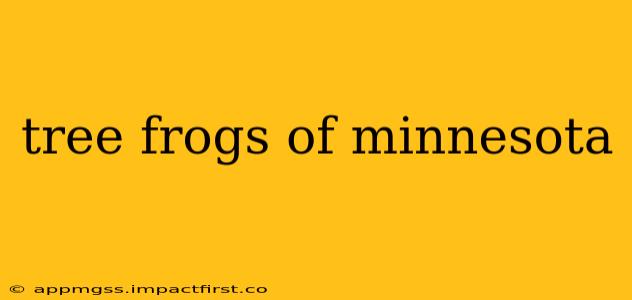Minnesota's amphibian population is diverse, and among its most captivating members are the tree frogs. These small, arboreal creatures bring a unique charm to the state's wetlands and forests. While Minnesota doesn't boast a large variety of tree frog species compared to more southern states, the ones found here are fascinating subjects for study and observation. This guide will delve into the tree frogs you might encounter in the North Star State, exploring their characteristics, habitats, and conservation status.
What kinds of tree frogs live in Minnesota?
Minnesota is home to only one true tree frog species: the Gray Treefrog ( Hyla versicolor). While other species may occasionally be sighted as a result of accidental transport or temporary migration, the Gray Treefrog is the resident species you're most likely to find.
Where can I find Gray Treefrogs in Minnesota?
Gray Treefrogs are found throughout much of Minnesota, but their distribution isn't uniform. They prefer habitats with ample moisture and vegetation. You're most likely to encounter them in:
- Deciduous forests: The abundant trees and undergrowth provide excellent shelter and hunting grounds.
- Wetlands and marshes: These areas provide crucial breeding grounds and a reliable source of insects.
- Near lakes and ponds: The proximity to water is essential for their lifecycle.
- Urban areas (occasionally): Gray Treefrogs are adaptable and can sometimes be found in parks and green spaces within cities.
Their presence is often indicated by their distinctive calls, particularly during the breeding season.
What do Gray Treefrogs eat?
Gray Treefrogs are insectivores, meaning their diet consists primarily of insects. Their diet typically includes:
- Moths
- Flies
- Beetles
- Grasshoppers
- Spiders
They are opportunistic hunters, ambushing their prey from concealed positions among leaves and branches.
What are the distinguishing characteristics of a Gray Treefrog?
Identifying a Gray Treefrog involves noting several key features:
- Size: Relatively small, usually 1.5 to 2 inches in length.
- Color: Highly variable, ranging from gray to green, often with darker markings. This camouflage helps them blend seamlessly with their surroundings.
- Skin: Smooth and moist.
- Toes: Possesses adhesive toe pads, allowing them to climb effectively on trees and other vertical surfaces.
- Call: A distinctive, resonant "chuck" or "croak," often described as a snoring sound. This call is particularly noticeable during the breeding season.
What is the breeding season for Gray Treefrogs in Minnesota?
The breeding season for Gray Treefrogs typically occurs from late spring to early summer, coinciding with warmer temperatures and the presence of suitable breeding sites. Males gather near water bodies and call to attract females. Eggs are laid in masses attached to vegetation in or near the water.
Are Gray Treefrogs poisonous or dangerous to humans?
No, Gray Treefrogs are not poisonous or dangerous to humans. They are harmless creatures that play an important role in the ecosystem. However, it is important to remember to always treat wildlife with respect and avoid handling them unnecessarily.
What are the conservation concerns for Gray Treefrogs in Minnesota?
While Gray Treefrogs are not currently considered endangered in Minnesota, their populations can be impacted by several factors:
- Habitat loss: The destruction and fragmentation of wetlands and forests threaten their breeding sites and foraging grounds.
- Pollution: Water pollution and pesticide use can negatively affect their health and survival.
- Climate change: Shifting climate patterns could alter their distribution and breeding cycles.
Supporting habitat conservation efforts is crucial for the long-term survival of Gray Treefrogs in Minnesota. Responsible stewardship of the environment is key.
Conclusion
The Gray Treefrog, while subtle in its presence, represents a significant part of Minnesota's amphibian biodiversity. Understanding its habitat preferences, diet, and conservation needs helps us appreciate and protect this fascinating creature and its vital role within the state's ecosystems. By appreciating and respecting these amphibian treasures, we ensure their continued presence in the Minnesota landscape for years to come.
